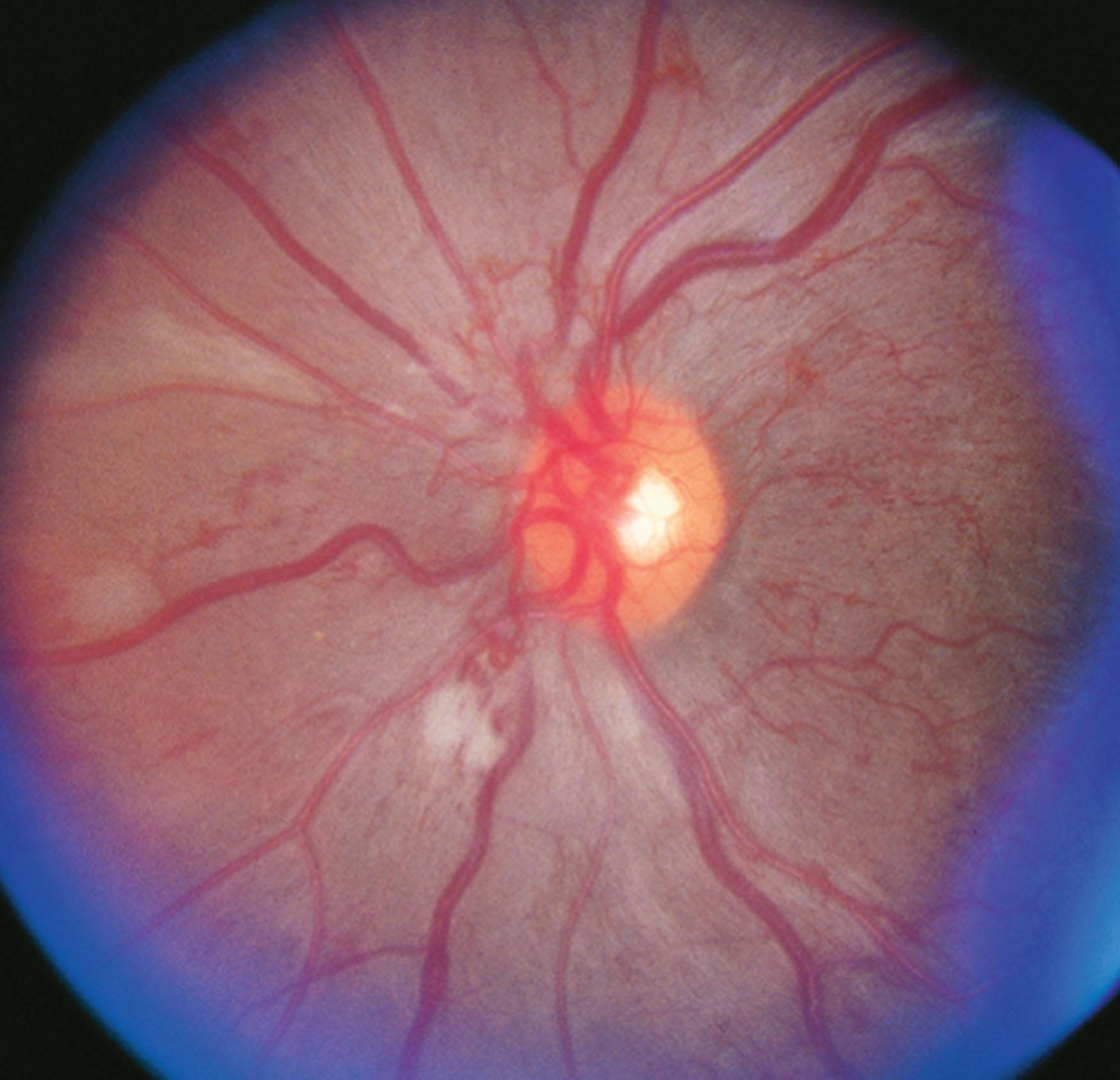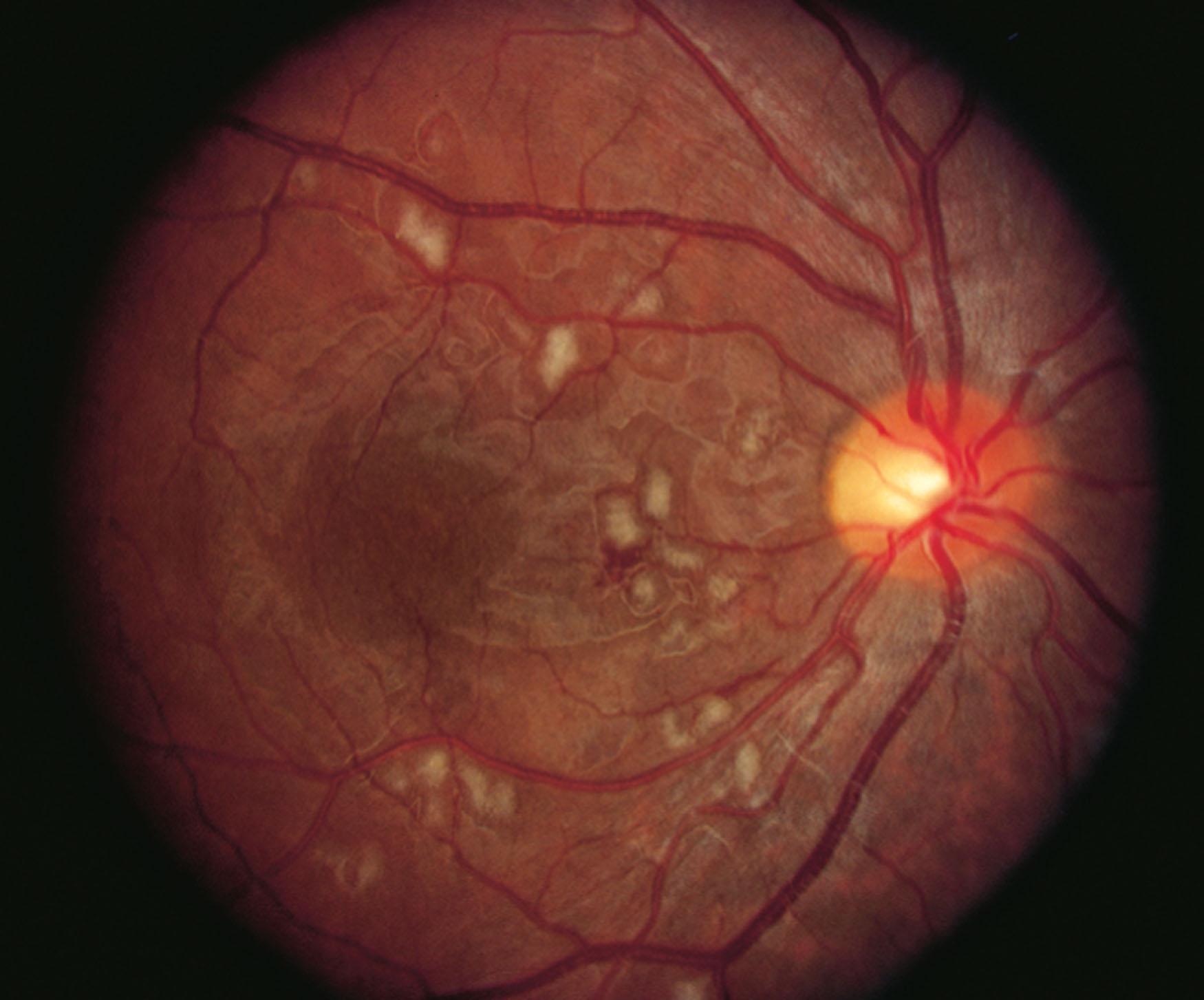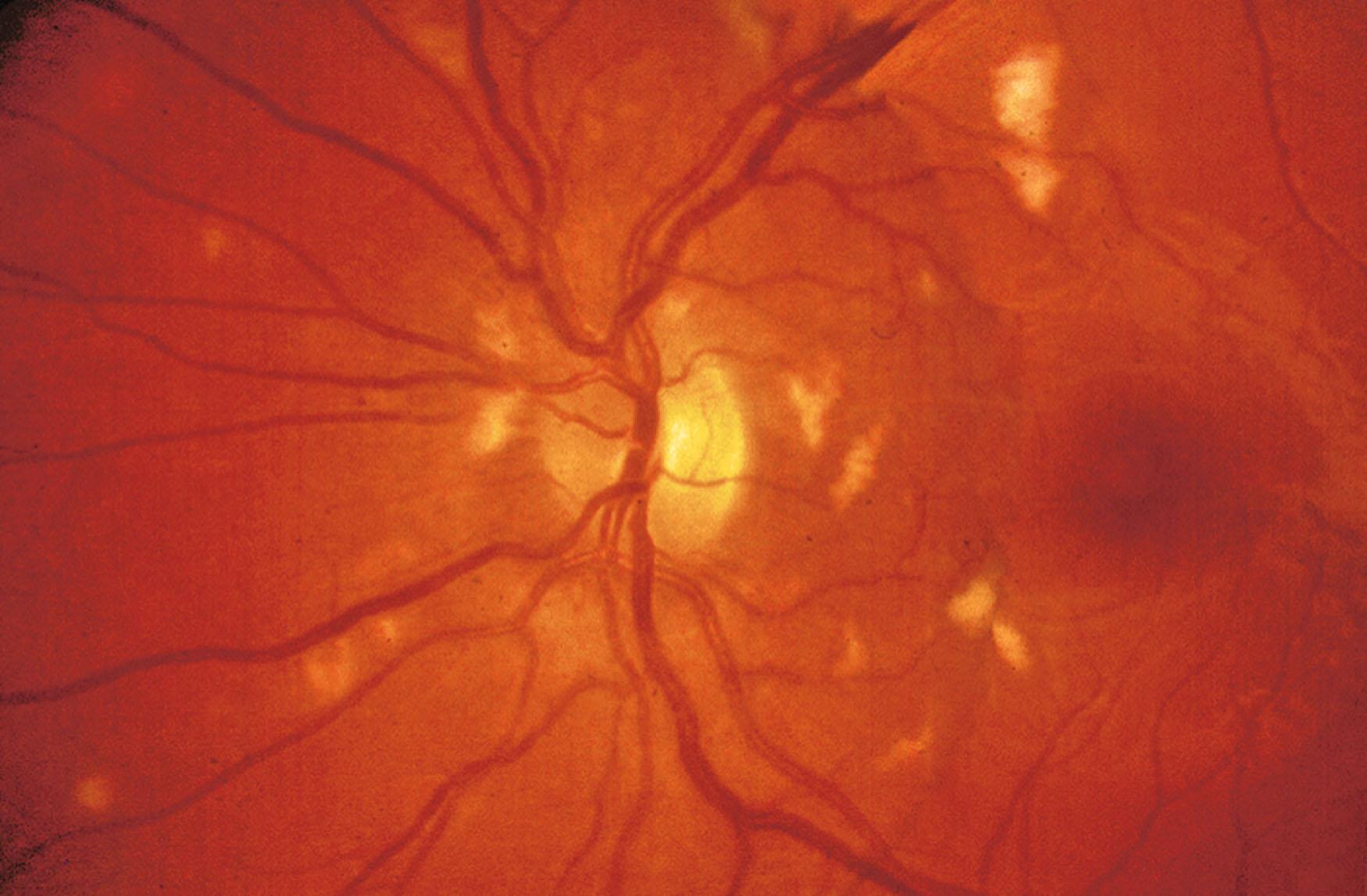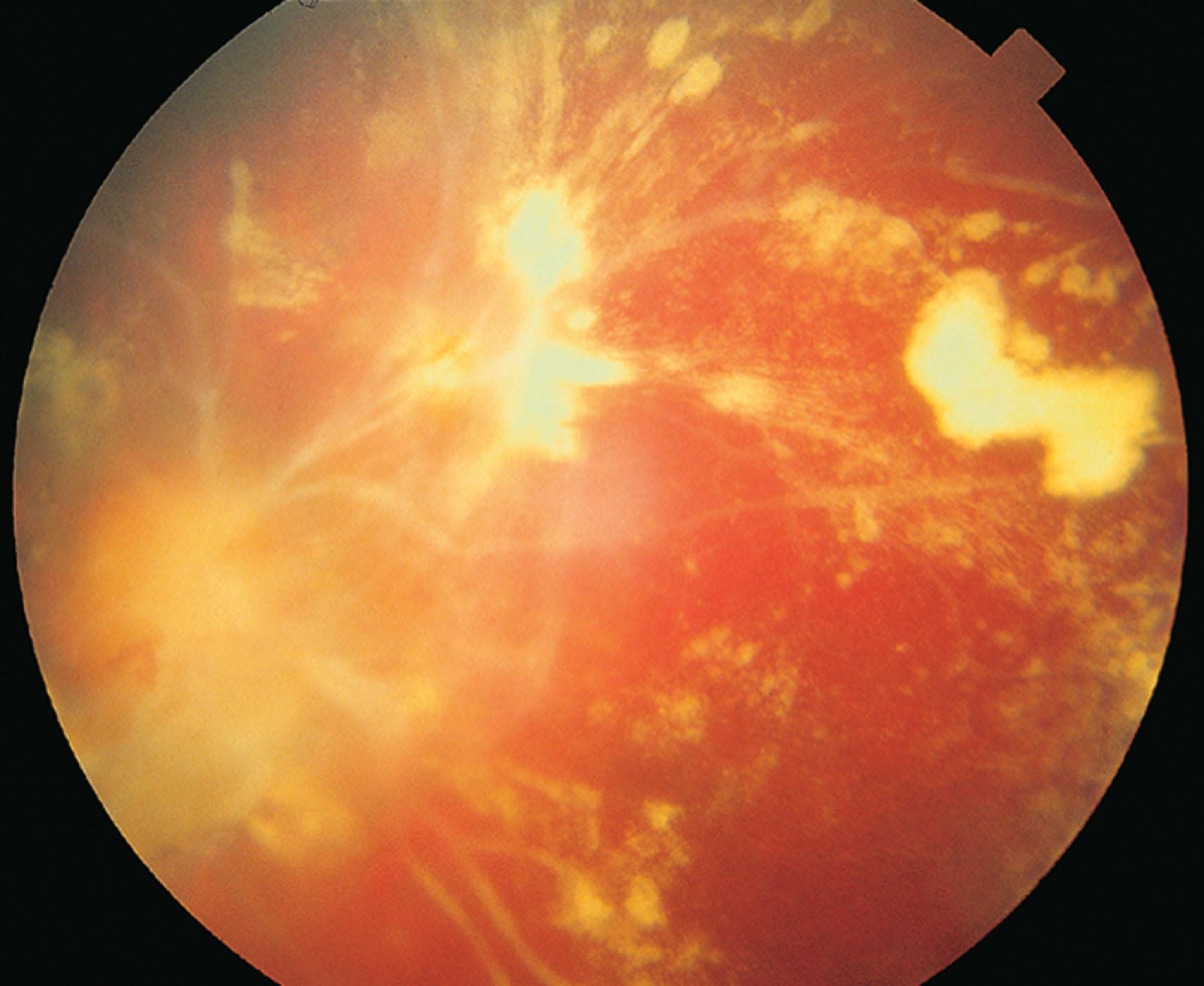Physical Address
304 North Cardinal St.
Dorchester Center, MA 02124
Diabetic retinopathy ( Fig. 50.1 ) is uncommon in children. It is strongly correlated with the duration of diabetes mellitus and the overall long-term metabolic control (mean glycosylated hemoglobin, HbA1c). Apart from that, a higher onset age of diabetes type 1 seems to be correlated with an increased incidence of diabetic macular edema. With improved diabetes care, the prevalence of diabetic retinopathy has decreased, both in adults and in children. However, this favorable trend is counteracted by an increase of the prevalence of both type 1 diabetes and type 2 diabetes in children. Globally, an increase from more than 125 million people with diabetes in 2010 to almost 200 million in 2030 is expected.

In the past, pediatric diabetes was almost exclusively the type 1 insulin-dependent form. With increasing childhood obesity, particularly in higher-income countries, type 2 diabetes and insulin resistance in children and adolescents is an emerging epidemic, comprising 8%–45% of all diabetes in children and adolescents. Impaired glucose tolerance was noted in 21% of obese children aged 11–18 years and 25% of obese children aged 4–10 years. As the prevalence of childhood-onset type 2 diabetes increases, the number of children with diabetic retinopathy will also increase.
Sight-threatening or proliferative retinopathy is very rare in children, but after puberty the prevalence increases sharply, probably because of metabolic causes and less compliance.
In a study in the United States, 4008 children and adolescents (<21 years) with newly diagnosed diabetes were followed for more than 3 years. During that time, 20 % of the type 1 diabetes patients (average age 12 years) developed diabetic retinopathy and 7.2 % of the type 2 diabetes patients did so (average age 18 years). This shows that postponing the fundoscopic screening in type 1 diabetics until 5 years after diagnosis might be insufficient. Another study showed that often, in spite of guidelines, screening in the United States (probably also elsewhere) is inadequate: only 35% of the youths were referred for screening.
Most guidelines recommend that the first fundus examination occurs after puberty or age 12 in children and adolescents with type 1 diabetes or after 5 years from diagnosis (whichever comes first) and immediately after diagnosis in type 2 diabetes. The DCCT-EDIC Research Group argues that screening should be tailored according to the individual risk factors and could be reduced by 58% using evidence-based rules, thereby reducing the burden to the healthcare system and costs. This seems reasonable, however, as Rosenberg showed, even simple guidelines are often not followed and more complicated guidelines probably even less so. We must also recognize that these children are likely to face a lot of medical problems during their lifetime.
Presently, there is great interest in genetic susceptibility to proliferative diabetic retinopathy. Correlations have been established, e.g. with the CACNB2 gene. Although this is not used for diagnostic purposes yet, it will improve our understanding of the pathophysiology.
Sickle cell retinopathy (SCR) is the most significant ophthalmological complication of sickle cell disease (SCD), a hemoglobinopathy that affects both children and adults. SCR has a wide spectrum of manifestations which may lead to irreversible vision loss if not diagnosed and treated early. SCR may be classified into stages from non-proliferative to proliferative. Clinical findings in non-proliferative SCR include peripheral retinal vascular closure, salmon-patch hemorrhages and black sunbursts (jet-black hyperpigmentations near the equator which develop after a deep intraretinal hemorrhage caused by a reactive proliferation of the retinal pigment epithelium). Proliferative SCR is characterized by the development of peripheral retinal neovascularization, eventually giving rise to a hallmark “sea fan” proliferative retinopathy ( Fig. 50.2 ). As a consequence, vitreous hemorrhage and tractional or rhegmatogenous retinal detachments may develop. The vascular growth factor ANGPTL-4 has been identified as a mediator of progression to proliferative SCR and may represent a possible therapeutic target. A recent Cochrane systematic review supported argon laser treatment to prevent visual loss and vitreous hemorrhage, with acceptable safety. Innovations such as targeted laser therapy to ischemic areas detected by ultra wide-field imaging with or without intravitreal anti-vascular endothelial growth factor (VEGF) injections may improve proliferative SCR treatment. In patients with vitreous hemorrhage or epiretinal membranes, pars plana vitrectomy is successful in improving vision. Recent healthcare improvements have increased the life expectancy of SCD patients making serial screening important to detect and treat proliferative SCR early before irreversible vision loss. Hydroxyurea is an example of an effective therapeutic agent in children with SCD, blocking the formation of sickle cell erythrocytes, and has been widely used in pediatric sickle cell centers.

Eye screening is indicated in homozygous patients (HbS/HbS; 10% risk of retinopathy), double heterozygous patients (HbS/HbC and HbS/Hb-beta-thalassemia; 40% risk of retinopathy) or when the sickle trait is present (HbS/ HbA) with additional systemic vascular conditions. Although the development of proliferative SCR is highly unlikely before the age of 10 years, innovative SD-OCT angiography revealed detectable changes in a majority of even younger patients, suggesting that routine retinal screening including SD-OCT examination should start earlier. Multidisciplinary teams may screen and treat severe cases more effectively. Stem cell transplantation and gene therapy are potential curative treatments and may prevent SCR in the future.
Radiation retinopathy in children is a delayed-onset complication of radiation exposure secondary to focal plaque (brachytherapy) or external beam treatment for retinoblastoma, orbital tumors, brain tumors and, rarely, uveal melanoma. Radiation retinopathy most commonly develops between 6 months and 3 years following treatment; however, retinal changes have been observed as early as 1 month following both plaque and external beam. It may be mild or progressive. Since the introduction of intra-arterial or intravenous chemotherapy combined with focal laser therapy as the first therapy of choice for retinoblastoma, the incidence of radiation retinopathy has declined. Unfortunately, superselective ophthalmic artery chemotherapy is also not without danger and may cause central retinal artery embolism or subacute choroidal occlusions. Radiation induces a cascade of changes in the retinal vascular architecture, predominantly in the macula, which lead to vascular non-perfusion, leakage, and proliferation. Histologic studies demonstrate a preferential loss of vascular endothelial cells with relative sparing of the pericytes (in contrast to the early loss of pericytes characteristic of diabetic retinopathy). Besides retinopathy, radiation may lead to maculopathy, cataract, neovascular glaucoma, optic neuropathy, persistent exudative retinal detachment, and scleral necrosis.
Various host and radiation parameters determine the risk of developing radiation retinopathy. The major modifiable risk factor is the total dose of radiation. More severe and extensive radiation retinopathy is associated with diabetes mellitus and the administration of chemotherapeutic agents.
Focal laser photocoagulation and anti-VEGF agents are used most often for treatment; periocular or intravitreal steroids are used with caution because of the side effects. Due to the rare occurrence and the variable severity of the condition, randomized trials in children are lacking.
Bone marrow transplantation (BMT) is largely supplanted by hematopoietic stem cell transplantation (HSCT); both may damage the retina in their own way. Bone marrow transplantation (BMT) retinopathy may affect the posterior pole in children and adults. The incidence ranges from 0% to 10%, although this is likely an underestimate since it is often asymptomatic. It usually occurs within 6 months after BMT. Typical manifestations include bilateral and symmetrical capillary non-perfusion, cotton-wool spots, and intraretinal hemorrhages, usually sparing the peripheral retina ( Fig. 50.3 ). Also, optic nerve edema may occur. Atypical cases show microaneurysms, hard exudates, and macular edema without cotton-wool spots. Visual acuity is normal or reduced and on OCT a fluctuating cystoid macular edema (CME) with subretinal fluid may be noted. Little is known about necessity of treatment: the sparse literature suggests spontaneous resolution without secondary retinal neovascularization. Although patients tend to have favorable visual outcomes, poor visual recovery is also reported. Regular and long-term follow-up starting within 6 months after treatment is recommended for early detection and treatment.

The etiology of BMT retinopathy is thought to be multifactorial and is incompletely understood. One clinicopathological case demonstrated a retinal endotheliopathy similar to radiation retinopathy. BMT may be confounded by treatment administered prior to transplantation, such as total body radiation, and is reported in cases after relatively low doses of previous total body radiation. However, BMT retinopathy may also occur in the absence of any radiation. While radiation retinopathy usually has a progressive course, BMT retinopathy usually is non-progressive.
BMT retinopathy can be differentiated from an infectious condition by an anterior chamber tap to exclude a viral retinitis. Iatrogenic origin may be tackled by tapering retinotoxic drugs such as cyclosporine.
After hematopoietic stem cell transplantation (HSCT) a cytomegalovirus (CMV) retinitis may occur as a characteristic side-effect. The risk of developing CMV retinitis is not well defined yet in the pediatric age group. A recent screening protocol for early detection recommends Retcam photographs at 3 and 12 months post HSCT.
Retinal vasculitis ( Fig. 50.4 ) is very rare in children and usually occurs in the setting of intermediate uveitis, posterior uveitis, or panuveitis. The causes are: (1) infectious (e.g. toxoplasmosis, viral (human immunodeficiency virus – HIV, human T-cell lymphotropic virus type-1, H1N1-influenza , Candida ; (2) non-infectious (e.g. collagen vascular disorders, Behçet’s disease, multiple sclerosis, idiopathic retinal vasculitis, aneurysms and neuroretinitis [IRVAN], systemic lupus erythematosus, Susac syndrome (once described in a 7-year-old) ; and (3) isolated idiopathic (Eales disease). The diagnosis of Eales disease is made by exclusion. Although usually seen in adult males, Eales disease may occur in children.

One has to be cautious, however, to exclude tuberculosis, as a hypersensitivity reaction to Mycobacterium tuberculosis may present as Eales disease. It is sometimes difficult to differentiate between vasculitis and vascular occlusion. Fluorescein angiography is very helpful to show vascular leakage, cystoid macular edema, or optic disc leakage as possible signs of inflammation. However, fluorescein angiography may be difficult to perform in children. An alternative is to perform an oral angiogram, by having the child swallow pure fluorescein dye with some sweetener and taking fundus photographs 20 minutes later. The time needed for the dye to appear in the fundus after passing the gastrointestinal system is variable.
Treatment will depend on the cause and the extent of the condition; often, laser photocoagulation and/or anti-VEGF therapy will be necessary to prevent bleeding from proliferative retinopathy.
Frosted branch angiitis (FBA) is a rare retinal disease typically occurring in otherwise healthy children and young adults. It is especially seen in Japan where it was first described by Ito in 1976. The pathognomonic fundal appearance is striking: extensive retinal perivascular sheathing due to exudates which cause the vessels (veins and arteries) to appear white. The retinal vasculitis is widespread and bilateral. Mild to moderate iritis with vitritis are common, as is retinal edema. Intraretinal hemorrhages and subretinal exudates are occasionally seen. Papillitis, if present, is usually mild. Fluorescein angiography may reveal leakage from the affected vessels without an occlusive vasculopathy. In spite of its often dramatic appearance ( Fig. 50.5 ) the prognosis is usually favorable, with good response to systemic steroid therapy. A viral illness may precede the onset in one-third of cases, suggesting a viral component. Many cases, however, remain idiopathic even after extensive work-up. FBA is associated in literature with a broad variety of conditions, including viral retinitis, syphilis, HIV, Behçet’s disease, reduced activity of the immune system, pregnancy, sarcoidosis, familial Mediterranean fever, perforating or blunt trauma, sympathetic ophthalmia, typhoid fever, antiphospholipid antibody syndrome, dengue hemorrhagic fever, multiple sclerosis, anti-VEGF endophthalmitis, infective endocarditis, dermatomyositis, toxoplasmosis. Infiltrative disorders such as lymphoma and leukemia or of paraneoplastic origin may mimic FBA and should be ruled out before diagnosis. Complications include secondary retinal vein or artery occlusion, macular epiretinal membrane formation, retinal tear formation, vitreous hemorrhage, optic disc atrophy, and peripheral atrophic retinal lesions.

Become a Clinical Tree membership for Full access and enjoy Unlimited articles
If you are a member. Log in here